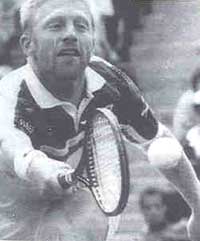A different ball game!
A different ball game!

PROFESSIONAL tennis players gracing the courts at Wimbledon may be rich and famous but they are also unwitting guinea-pigs in a new experiment in which the laws of physics - and especially aerodynamics - are being put to use to bring about certain changes.
The past 10 years have seen the emergence of the 'power game'. Tennis rackets have become upto 20 per cent sturdier as manufacturers use stiff graphite fibres and make them large- headed. The players themselves have become taller and stronger; most of the top 10 men being over 183 cms (6 ft). The result is that the service speed has risen, so that on Centre Court they typically average 100 mph. But, the tennis balls remain the same. Since the above factors cannot be altered, all that tournament organisers can do is slowing down the balls to make the game more thrilling.
Two factors are crucial in deciding the speed at which the ball travels: the resilience of the rubber (to which the internal pressure contributes) and its effective cross-section, which affects the ball's air resistance.
Attempts were made this year at Wimbledon to use balls which were pressurised at two per cent below the norm. However due to the hot weather the balls heated up very fast reaching the same speed as normal balls within a couple of rallies.
Geoff Thwates of GT Technology, Cambridge, recently ran a series of computer simulations of the effect of pressure reduction on tennis balls. He found that while a ball rebounds about five per cent less when bouncing on a hard surface," the velocity of the ball off the racket is only decreased by one per cent for the same pressure reduction". Therefore it is the velocity of the ball off the server's racket which really matters and that which needs to be altered if the player's opponent is to be given an increased chance of returning a service. Thwaites also warned that softer balls will skid further "and may cause more difficulty with line calls".
Organisers of the French open, held in Paris, tried a similar experiment but by incorporating smaller balls. Their object was to speed up the game rather than slow it down: their floor surface, of crushed brick, is one of the slowest in the world, while Wimbledon's is the fastest.
The Wimbledon balls use the same rubber as those in the French Open, but at a lower pressure, which means that when a racket hits the ball, it 'gives' more. But when the rubber - and consequently the gas inside the ball heats up, the pressure rises again.
To increase the cross-section would mean that the ball slows down quicker as it volleys through the air." To really have an effect, you would have to look for a 10 per cent reduction in the speed of the balls," says Robert Haines, a technical consultant to the International Tennis Federation who has worked for the ball manufacturer Dunlop - Slazenger for the past 30 years. "You would have to make the ball's cross-section about 20 per cent bigger. To get a 10 per cent reduction by lowering the pressure, you'd get a pretty squashy ball. It would be unsatisfactory to the players", Haines adds. Thwates's computer studies had also yielded the same results. It seems from these results that little can be done with the ball to change the game.
Meanwhile, professional tennis players could probably resign themselves-to their fate as the best-paid and most glamorous scientific guinea-pigs in the world.







